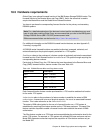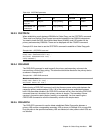220 IBM System Storage DS6000 Series: Copy Services with IBM System z
19.1 Performance
As the distance between DS6000s increases, Metro Mirror response time is proportionally
affected, and this negatively impacts the application performance. When implementations
over extended distances are needed, Global Copy becomes an excellent trade-off solution.
You can estimate the impact of Global Copy on an application as that of the application when
working with Metro Mirror suspended volumes. For the DS6000, there is more work to do with
the Global Copy volumes, as compared to the suspended volumes, because with Global
Copy, the changes have to be sent to the remote DS6000. But this is a negligible overhead
for the application, as compared with the typical synchronous overhead.
No processor resources (CPU and memory) are consumed by your Global Copy volume
pairs, as this is managed by your DS6000 subsystem.
19.1.1 Peak bandwidth requirements
When you are researching your Global Copy link bandwidth requirements, you need to find
the
peak sustained write rate - remember that only writes will be mirrored across to the
secondary volumes. For a typical z/OS system, this peak is usually reached during batch
processing, when many updates are occurring. It could be higher still during month-end or
year-end processing. You need to make allowances for this peak period when performing
your bandwidth calculations.
19.2 Scalability
The DS6000 Global Copy environment can be scaled up or down as required. If new volumes
are added to the DS6000 that require mirroring, they can be dynamically added. If additional
Global Copy paths are required, they also can be dynamically added.
19.2.1 Addition of capacity
As previously mentioned, the logical nature of the LSS has made a Global Copy
implementation on the DS6000 easier to plan, implement, and manage.
However, if you need to add more LSSs to your Global Copy environment, your management
and automation solutions should be set up to handle this. The GDPS and eRCMF service
offerings are designed to provide this functionality; see Part 8, “Solutions” on page 431, for
more information. Also visit the IBM Web site and see the Services & Industry Solutions page.
Adding capacity to the same DS6000
If you are adding capacity into an existing DS6000, and providing that your Global Copy link
bandwidth is not close to or over its limit, you might only need to add volume pairs into your
configuration. If you are adding more LSSs, then you will need to define Global Copy paths
before adding volume pairs. Keep in mind that when you add capacity for Global Copy use,
you might have to acquire a new license feature code for Global Copy that corresponds to the
new capacity.
Adding capacity to new DS6000s
If you are adding new DS6000s into your configuration, you must add physical links before
defining your Global Copy paths and volume pairs. A minimum of two Global Copy paths per
DS6000 pair is recommended for redundancy reasons. Your bandwidth analysis can indicate
if you require more than two paths.


















